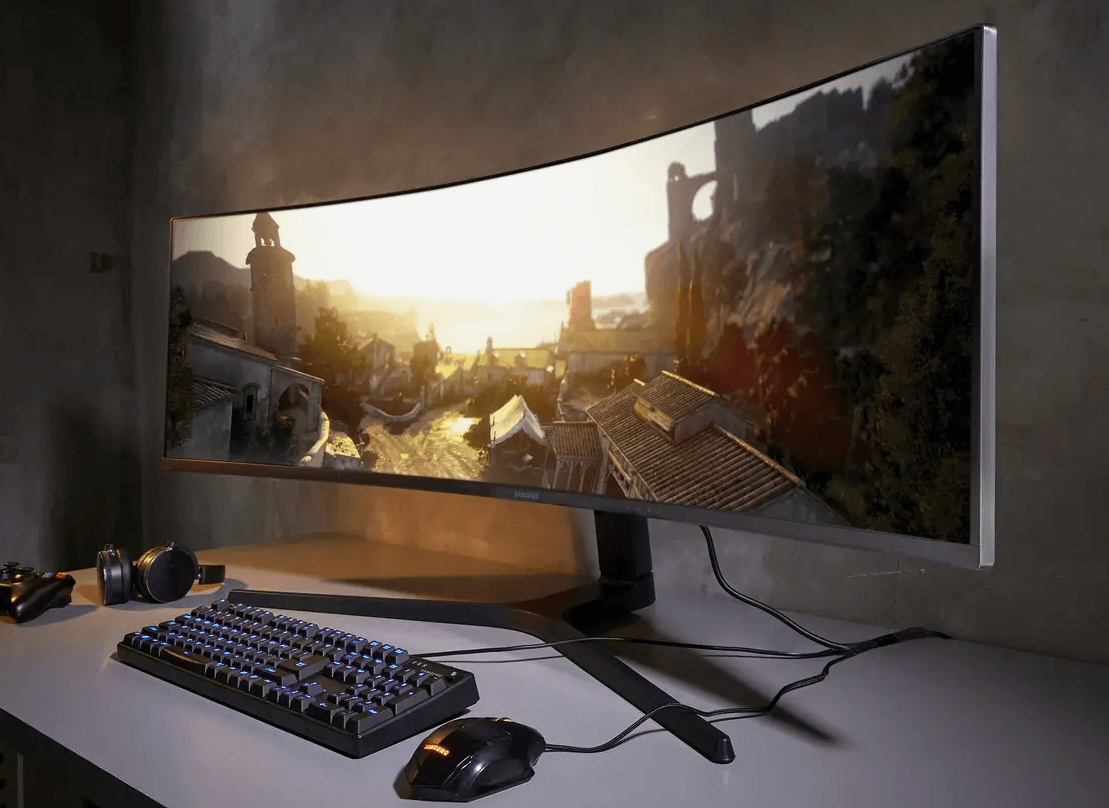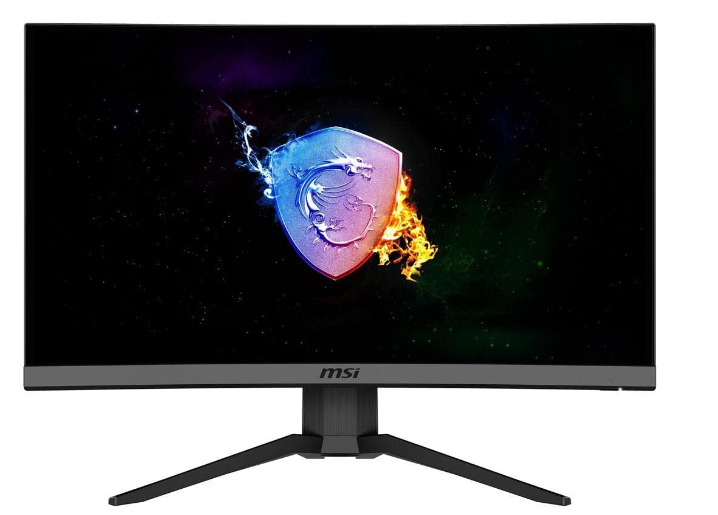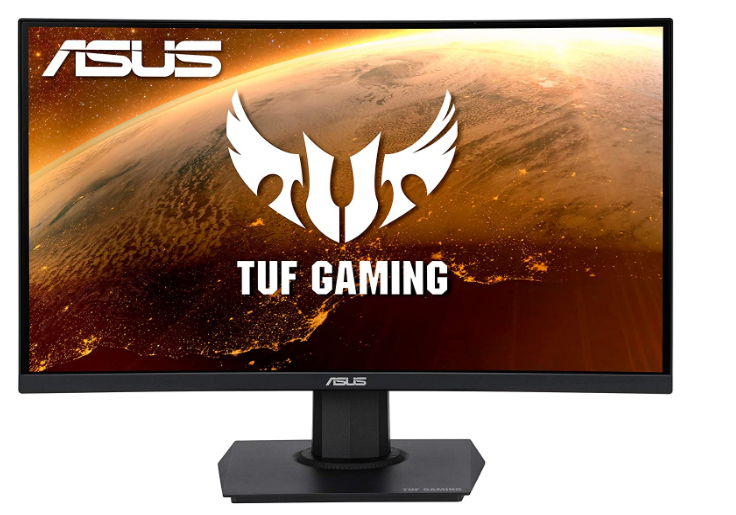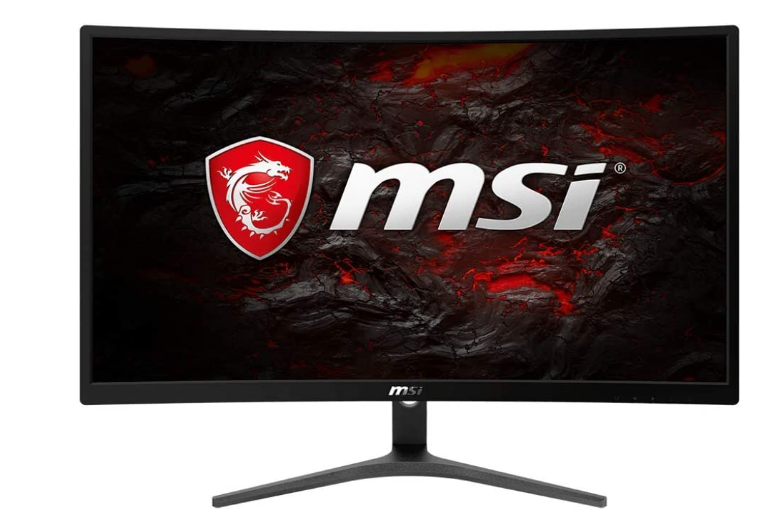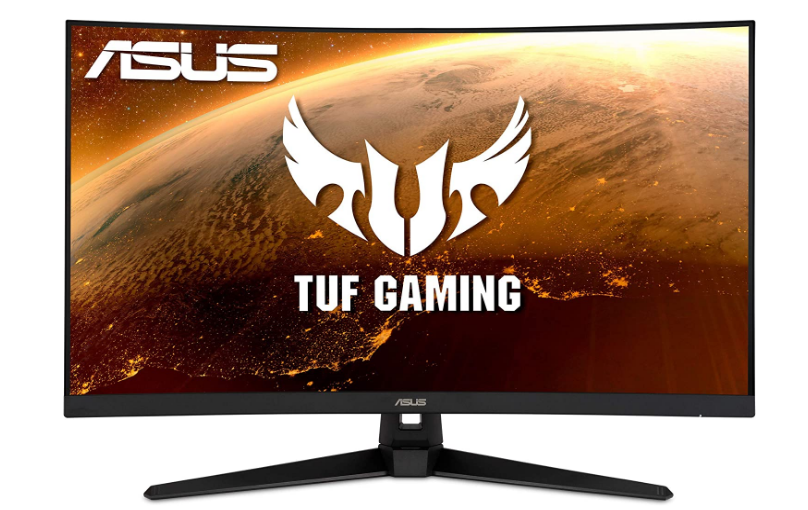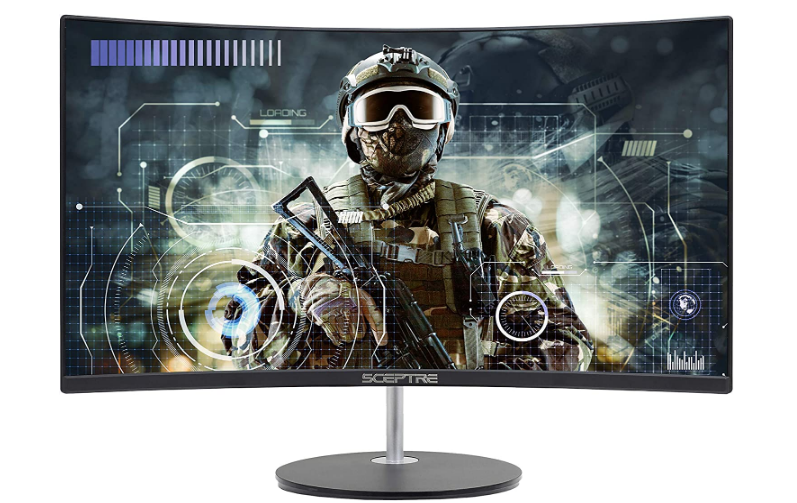Curved gaming monitors have become increasingly popular due to their immersive gaming experience and enhanced visuals. This review will provide an in-depth analysis of five popular curved gaming monitors, examining their features, pros, cons, and customer opinions. We will be looking at the following models: MSI Optix G24C, ASUS TUF Gaming VG24VQE, MSI Optix G24C (75Hz), ASUS TUF Gaming VG328H1B, and Sceptre 24″ Curved 75Hz Gaming LED Monitor.
Best Curved Gaming Monitors in Canada 2023
-
MSI Optix G24C
Features:
- 24″ Curved Non-Glare LED Screen: The MSI Optix G24C features a 24-inch curved screen with a non-glare surface, reducing reflections and providing a more comfortable viewing experience during extended gaming sessions.
- Full HD Resolution (1920 x 1080): This monitor offers a crisp and clear full HD resolution, delivering detailed and vibrant visuals that enhance your gaming experience.
- 144Hz Refresh Rate: The high refresh rate of 144Hz ensures smooth gameplay, reducing screen tearing and stuttering. This allows for fast-paced action games to be played without any interruptions or motion blur.
- 1ms Response Time: The rapid 1ms response time minimizes ghosting and trailing effects, ensuring that fast-moving objects appear sharp and clear.
- FreeSync Technology: With AMD FreeSync technology, the MSI Optix G24C dynamically synchronizes the monitor’s refresh rate with the graphics card’s frame rate, eliminating screen tearing and providing a smoother gaming experience.
-
ASUS TUF Gaming VG24VQE
Features:
- 23.6″ Curved Monitor: The ASUS TUF Gaming VG24VQE features a 23.6-inch curved screen, providing an immersive gaming experience and reducing eye strain during extended use.
- 1080P Full HD Resolution: This monitor offers a full HD 1080p resolution, delivering stunning visuals and detailed images.
- 165Hz Refresh Rate (Supports 144Hz): The VG24VQE supports a high refresh rate of up to 165Hz, ensuring smooth and fluid gameplay. It is also compatible with 144Hz, providing flexibility for different gaming needs.
- 1ms Response Time & Extreme Low Motion Blur: With a fast 1ms response time and Extreme Low Motion Blur technology, the ASUS TUF Gaming VG24VQE minimizes ghosting and motion blur, providing clear and sharp images even in fast-paced games.
- FreeSync Premium & Shadow Boost: The monitor supports AMD FreeSync Premium technology, which eliminates screen tearing and provides smooth gameplay. The Shadow Boost feature enhances dark areas in games without overexposing brighter areas, improving overall visibility.
-
MSI Optix G24C (75Hz)
Features:
- 24″ Curved Non-Glare LED Screen: Like its 144Hz counterpart, the MSI Optix G24C (75Hz) also features a 24-inch curved screen with a non-glare surface, providing an immersive gaming experience without reflections.
- Full HD Resolution (1920 x 1080): This monitor offers full HD resolution, ensuring detailed and vibrant visuals.
- 75Hz Refresh Rate: With a 75Hz refresh rate, the MSI Optix G24C (75Hz) provides smooth gameplay and reduces screen tearing. This refresh rate is suitable for casual gamers or those who prioritize a more budget-friendly option.
- 1ms Response Time: The fast 1ms response time minimizes ghosting and trailing effects, ensuring sharp and clear images in fast-moving games.
- FreeSync Technology: AMD FreeSync technology is also available in this model, synchronizing the monitor’s refresh rate with the graphics card’s frame rate for a smooth gaming experience.
-
ASUS TUF Gaming VG328H1B
Features:
- 32″ Curved Monitor: The ASUS TUF Gaming VG328H1B features a large 32-inch curved screen, providing an immersive gaming experience and reducing eye strain during extended use.
- Full HD Resolution (1920 x 1080): This monitor offers full HD resolution, ensuring detailed and vibrant visuals.
- 165Hz Refresh Rate: With a high refresh rate of 165Hz, the ASUS TUF Gaming VG328H1B delivers smooth and fluid gameplay, minimizing screen tearing and stuttering.
- 1ms Response Time: The rapid 1ms response time of this monitor reduces ghosting and trailing effects, providing sharp and clear visuals even in fast-paced games.
- FreeSync Premium Technology: This monitor supports AMD FreeSync Premium technology, which eliminates screen tearing and ensures a smooth gaming experience.
-
Sceptre 24″ Curved 75Hz Gaming LED Monitor ( best curved monitor for office work)
Features:
- 24″ Curved LED Screen: The Sceptre 24″ Curved Gaming LED Monitor features a 24-inch curved screen that offers an immersive gaming experience and minimizes eye strain.
- Full HD Resolution (1920 x 1080): This monitor provides full HD resolution for detailed and vibrant visuals during gameplay.
- 75Hz Refresh Rate: With a 75Hz refresh rate, the Sceptre monitor ensures smooth gameplay and reduces screen tearing, making it a suitable option for casual gamers.
- Fast Response Time: The monitor has a fast response time, reducing ghosting and trailing effects for clear and sharp images in fast-moving games.
- HDMI and VGA Inputs: The Sceptre monitor supports both HDMI and VGA inputs, offering flexibility in connecting various devices.
Curved Gaming Monitors Buyers Guide
- Screen Size: Curved gaming monitors come in various screen sizes, typically ranging from 24 to 34 inches. Larger screens offer a more immersive gaming experience, but they also require more desk space. Consider your available space and the distance you’ll be sitting from the monitor to determine the ideal screen size for your needs.
- Resolution: The monitor’s resolution refers to the number of pixels displayed horizontally and vertically. Higher resolutions provide sharper and more detailed images. Common resolutions for gaming monitors include Full HD (1920 x 1080), Quad HD (2560 x 1440), and 4K Ultra HD (3840 x 2160). Keep in mind that higher resolutions require more powerful hardware to maintain smooth gameplay, so ensure your PC’s GPU can handle the desired resolution.
- Refresh Rate: The refresh rate, measured in Hertz (Hz), indicates the number of times per second that the monitor updates the image on the screen. Higher refresh rates result in smoother gameplay and reduced screen tearing. For gaming, a refresh rate of at least 60Hz is recommended, but competitive gamers may prefer rates of 144Hz or higher for more fluid visuals.
- Response Time: Response time, measured in milliseconds (ms), refers to how quickly the monitor’s pixels can change from one color to another. Faster response times reduce ghosting and motion blur, which is crucial for fast-paced games. A response time of 5ms or lower is generally considered suitable for gaming, with 1ms being the ideal for competitive gaming.
- Adaptive Sync Technology: Adaptive sync technologies, such as NVIDIA G-Sync and AMD FreeSync, synchronize the monitor’s refresh rate with your GPU’s output, reducing screen tearing and stuttering. This results in a smoother gaming experience. Make sure the monitor you choose is compatible with your GPU’s adaptive sync technology.
- Panel Type: There are three main panel types found in gaming monitors: TN (Twisted Nematic), IPS (In-Plane Switching), and VA (Vertical Alignment). Each panel type has its pros and cons in terms of color accuracy, viewing angles, response time, and contrast ratio. IPS panels typically offer better color reproduction and wider viewing angles, while TN panels excel in response time. VA panels provide higher contrast ratios but may have slower response times compared to the other two types.
- Connectivity Options: Ensure the monitor has the necessary input ports to connect your devices, such as HDMI, DisplayPort, or USB-C. Some monitors also feature additional USB ports for peripherals or built-in speakers for audio output.
- Ergonomics and Adjustability: An adjustable stand that allows you to change the monitor’s height, tilt, swivel, and pivot can enhance comfort during extended gaming sessions. VESA mount compatibility is another factor to consider if you plan to mount your monitor on a wall or a dedicated monitor arm.
- Budget: Lastly, establish a budget for your curved gaming monitor. Higher-end monitors with advanced features tend to be more expensive, but there are also affordable options available with decent specifications. Determine your priorities and balance your needs with your budget to find the best curved gaming monitor for you.
Uses of Curved Gaming Monitors:
- Immersive Gaming Experience: The curved design of these monitors wraps around your peripheral vision, creating a more immersive gaming experience. This can enhance the overall enjoyment and realism of playing video games, especially in genres such as racing, first-person shooters, and open-world exploration.
- Enhanced Visual Comfort: Curved monitors are designed to follow the natural curvature of the human eye, reducing eye strain and fatigue during extended gaming sessions. The curved shape also minimizes image distortion, resulting in a more consistent viewing experience across the entire screen.
- Improved Sense of Depth: The curvature of the screen can enhance the sense of depth in games, making 3D environments feel more lifelike and engaging. This can be particularly beneficial for virtual reality (VR) gaming, where depth perception is crucial to the experience.
- Wider Field of View: Curved gaming monitors often have a wider field of view compared to their flat counterparts, providing a more expansive and panoramic view of the in-game environment. This can give gamers a competitive edge by allowing them to see more of the game world at once.
- Multitasking: Larger curved monitors can be beneficial for multitasking, as they provide ample screen real estate to display multiple applications simultaneously. This can be useful for gamers who stream their gameplay or want to keep an eye on social media or chat applications while gaming.
Frequently Asked Questions:
Are curved monitors better for gaming than flat monitors?
This depends on personal preference. Curved monitors offer a more immersive gaming experience and can reduce eye strain, but some gamers may prefer the traditional look and feel of a flat monitor. It’s essential to try both types before making a decision.
Do curved monitors have more input lag?
Input lag is not inherently affected by the curvature of a monitor. The input lag depends on the monitor’s response time, refresh rate, and other internal components.
Can I use a curved monitor for purposes other than gaming?
Yes, curved monitors can be used for various tasks, including watching movies, browsing the web, and working on office applications. However, they are primarily designed for gaming, and some users may find the curved screen less suitable for tasks that require precise image alignment, such as graphic design or photo editing.
Are curved monitors compatible with all gaming consoles?
Curved monitors with HDMI or DisplayPort inputs should be compatible with most gaming consoles. However, it’s essential to check the monitor’s specifications and the console’s output capabilities to ensure compatibility.
How do I clean and maintain a curved gaming monitor?
To clean a curved gaming monitor, use a soft, lint-free cloth and a solution of mild soap and water. Avoid using harsh chemicals or abrasive materials that could damage the screen. Keep the monitor away from direct sunlight, excessive heat, and moisture to prolong its lifespan.
Conclusion:
Curved gaming monitors offer an immersive gaming experience with their curved screens and high-quality visuals. The MSI Optix G24C, ASUS TUF Gaming VG24VQE, MSI Optix G24C (75Hz), ASUS TUF Gaming VG328H1B, and Sceptre 24″ Curved 75Hz Gaming LED Monitor all provide unique features, pros, and cons to cater to different gaming needs. By considering factors such as screen size, resolution, refresh rate, response time, and additional features, you can choose the best curved gaming monitor for your specific requirements.

“Proud thinker. Tv fanatic. Communicator. Evil student. Food junkie. Passionate coffee geek. Award-winning alcohol advocate.”

